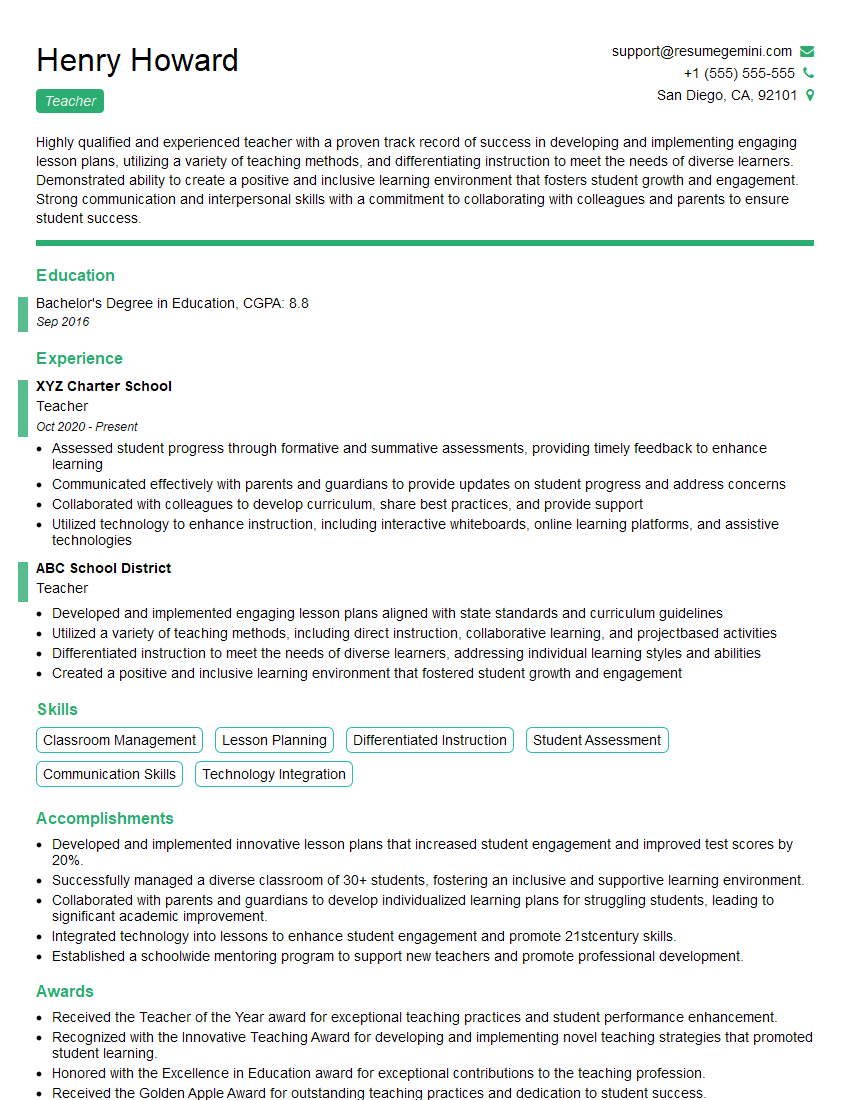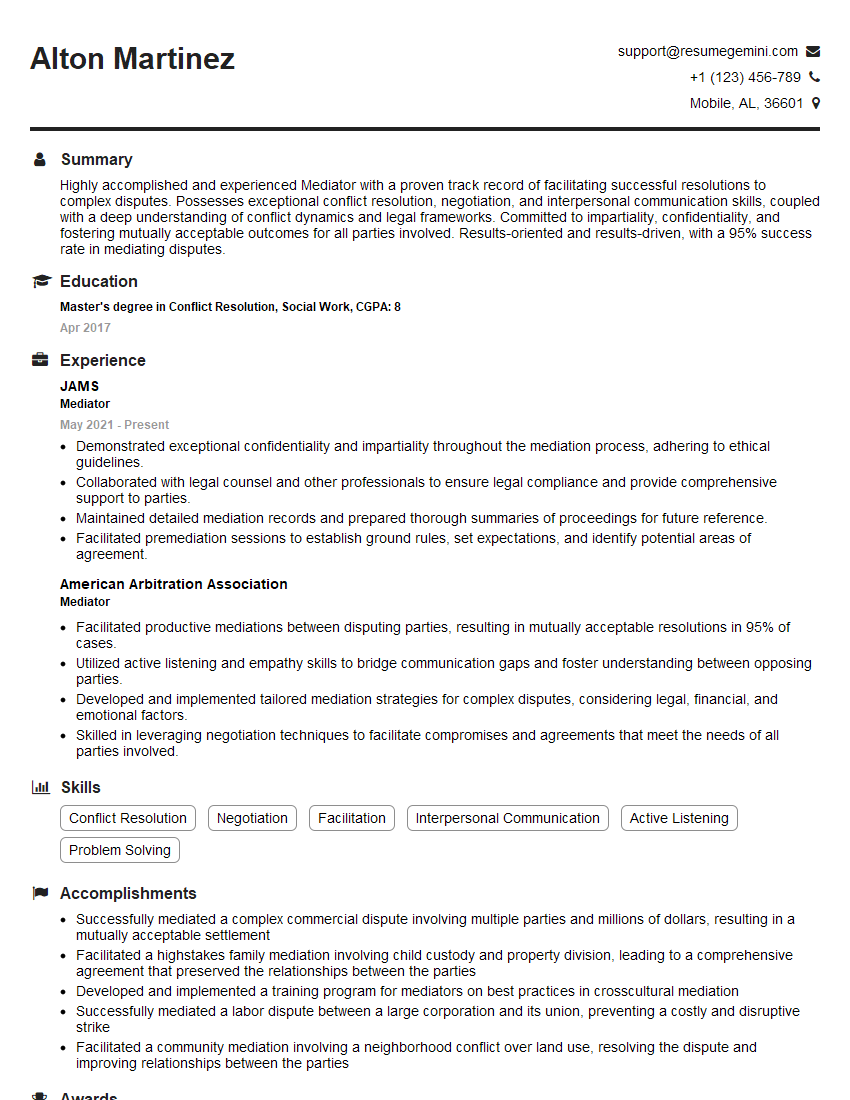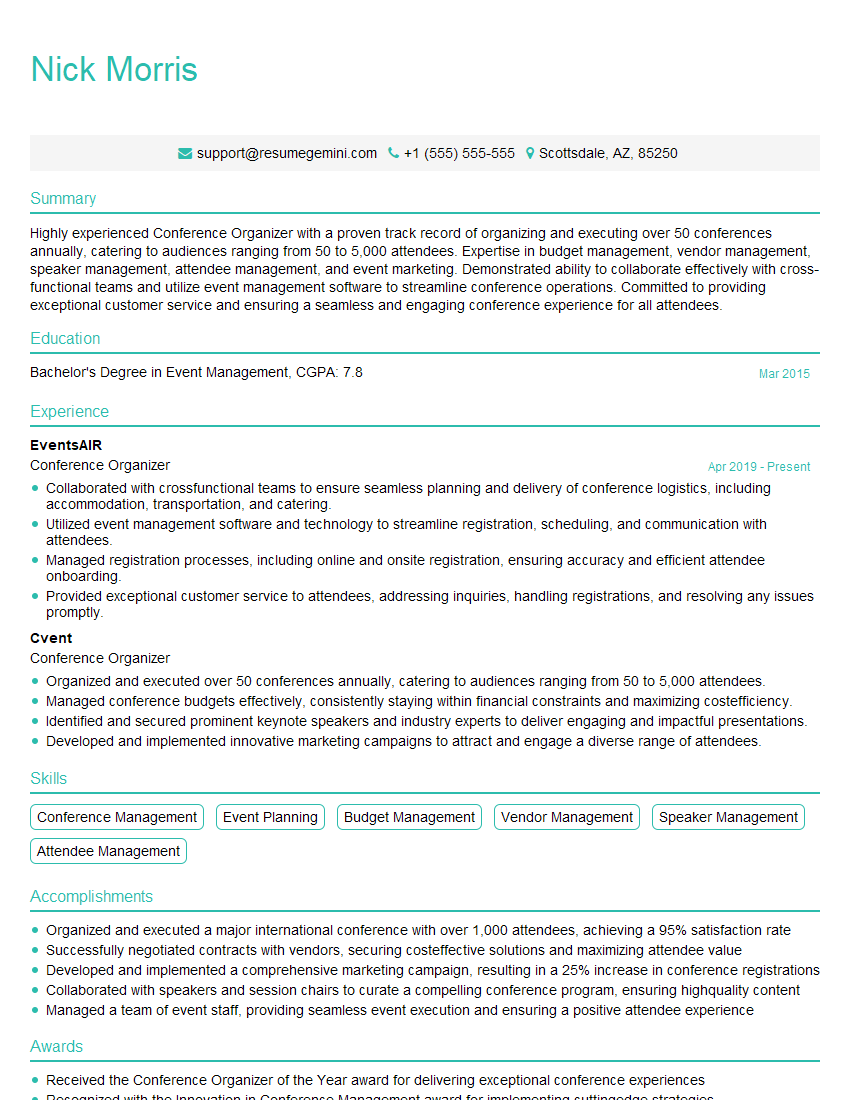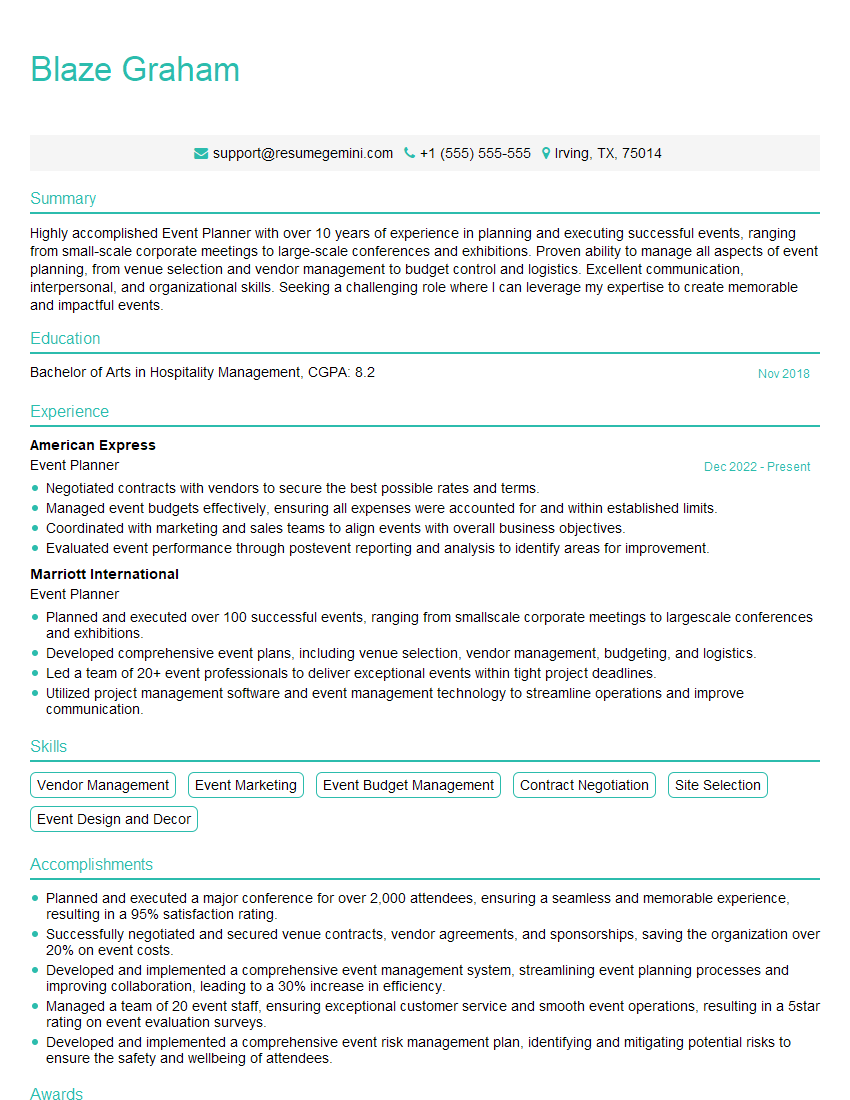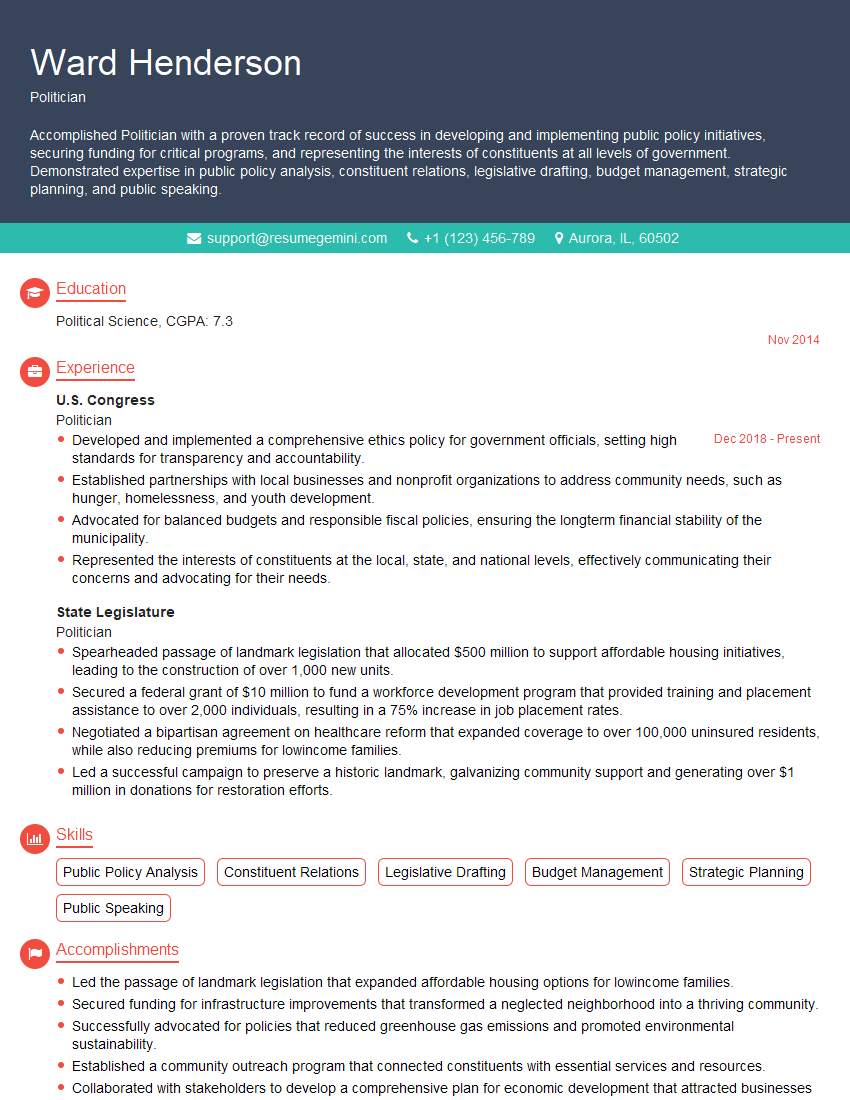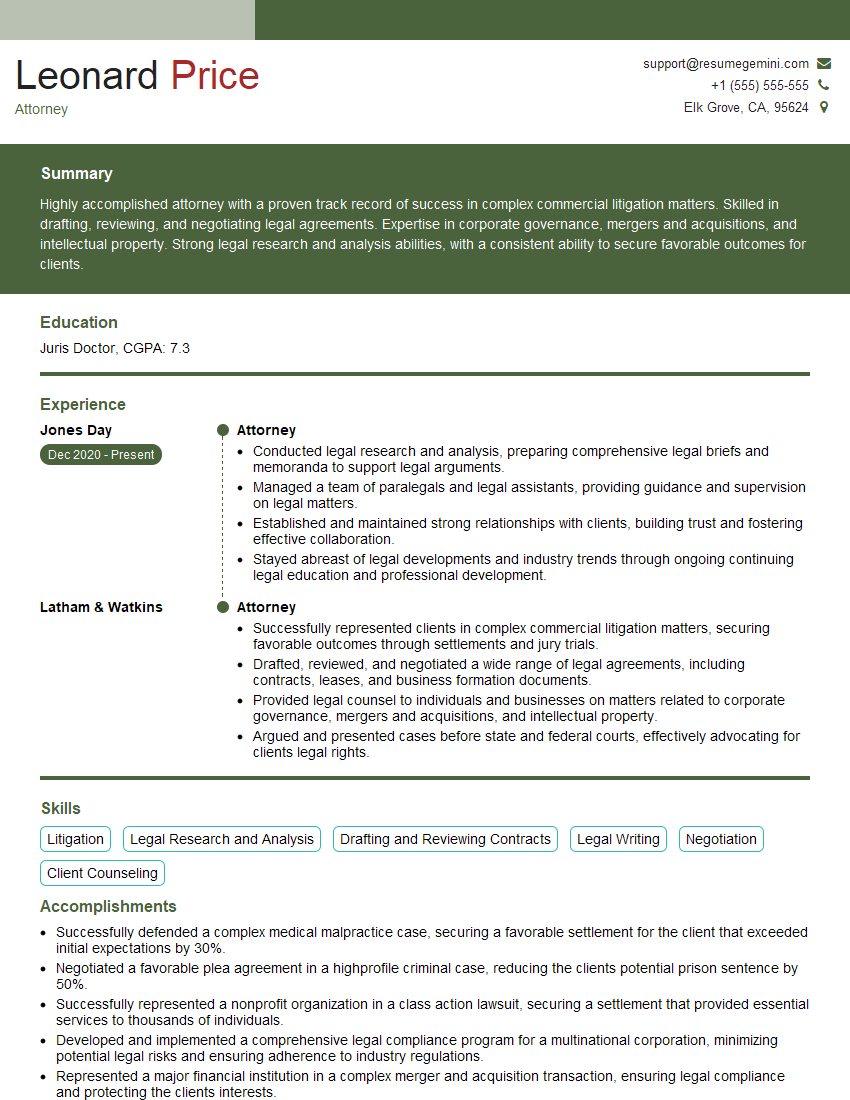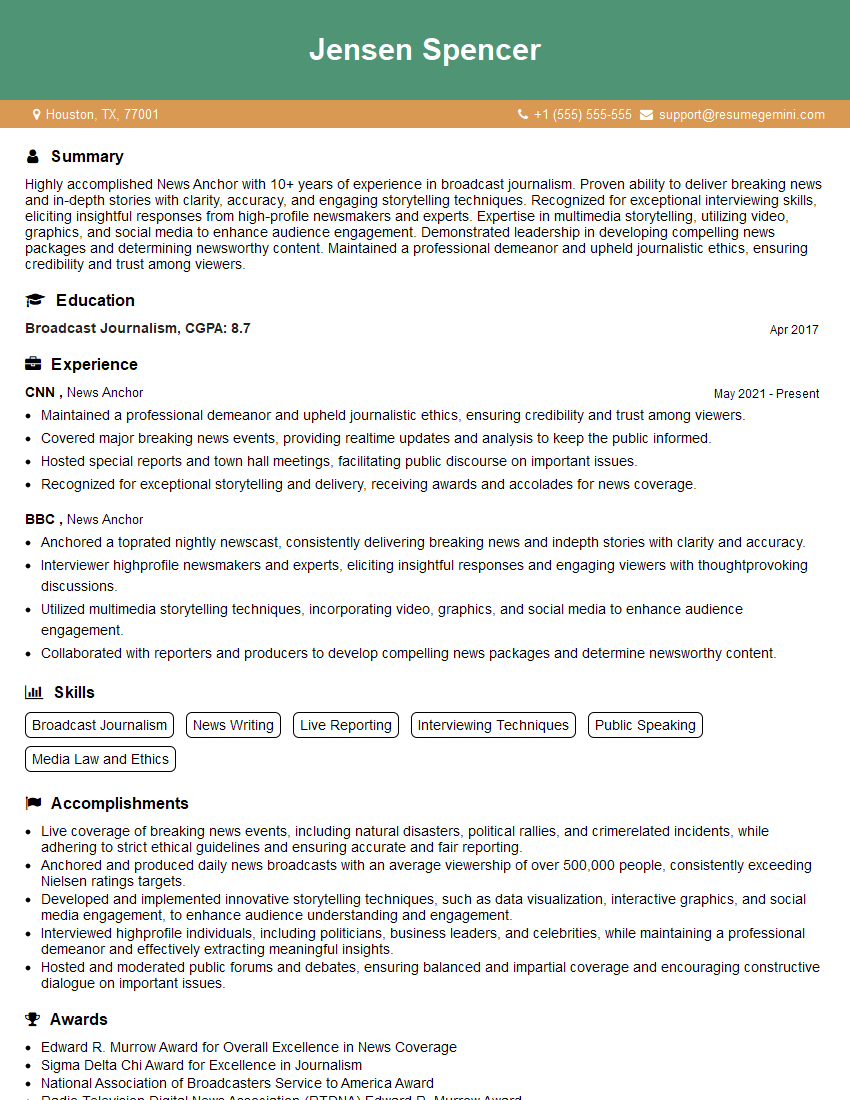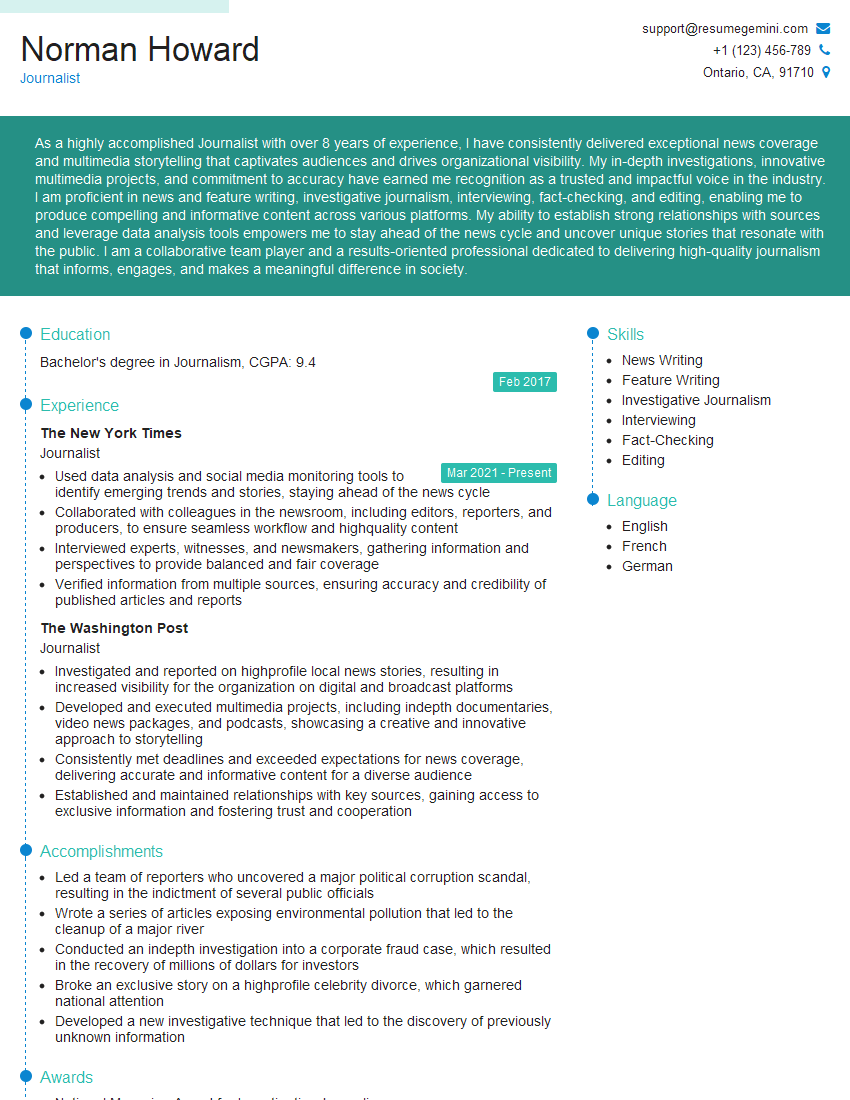Interviews are more than just a Q&A session—they’re a chance to prove your worth. This blog dives into essential Skill: Verbal Communication and Public Speaking interview questions and expert tips to help you align your answers with what hiring managers are looking for. Start preparing to shine!
Questions Asked in Skill: Verbal Communication and Public Speaking Interview
Q 1. Describe your approach to delivering a presentation to a large, diverse audience.
My approach to presenting to a large, diverse audience centers around meticulous planning and audience-centric delivery. I begin by thoroughly researching my audience – understanding their background, knowledge level, and potential interests. This allows me to tailor my content and language to resonate with them. For example, a presentation to a group of technical experts would require a different level of detail and jargon than a presentation to a general audience.
Next, I structure my presentation with a clear narrative arc, starting with a compelling hook to grab attention, followed by a logical flow of information, interspersed with engaging examples and anecdotes. Visual aids, such as charts, graphs, and images, are carefully chosen to reinforce key points and enhance understanding. I incorporate interactive elements, like polls or Q&A sessions, to maintain audience engagement throughout. Finally, I practice the presentation thoroughly, paying attention to pacing, tone, and body language to ensure a confident and polished delivery.
Crucially, I also factor in potential cultural differences within the audience. This might involve being mindful of nonverbal communication cues, adapting my humor to avoid potential misunderstandings, and ensuring my language is inclusive and respectful of diverse perspectives.
Q 2. How do you adapt your communication style to different audiences and situations?
Adapting my communication style is paramount to effective public speaking. I use a framework that considers three key elements: audience, context, and objective.
- Audience: I assess the audience’s prior knowledge, their expectations, and their level of formality. For example, a presentation to senior executives will require a more formal and concise approach than a presentation to a group of students. I also consider the audience’s cultural background and any potential sensitivities.
- Context: The setting itself plays a vital role. A casual workshop demands a relaxed and interactive style, while a formal conference necessitates a more structured and professional approach. The available technology also dictates the style – a presentation using only a whiteboard will differ significantly from one using advanced multimedia.
- Objective: My communication style is directly influenced by my goal. Am I aiming to inform, persuade, or inspire? Each objective requires a different emphasis in delivery, with persuasive speeches employing more rhetorical devices and inspirational talks relying on storytelling and emotional connection.
For example, when delivering a technical presentation to a non-technical audience, I would avoid jargon and utilize analogies and simple examples to explain complex concepts. Conversely, a presentation to a highly technical audience would allow for the use of specialized terminology and a deeper dive into the subject matter.
Q 3. Explain your experience crafting compelling narratives for presentations or speeches.
Crafting compelling narratives is fundamental to engaging any audience. I view presentations as stories, with a beginning (introduction), middle (main points), and end (conclusion). I employ several techniques to weave compelling narratives:
- Strong opening hook: This could be a surprising statistic, a relevant anecdote, or a provocative question to immediately capture attention.
- Character development: Even in a business presentation, I try to create relatable characters or scenarios. This helps the audience connect with the material on a personal level.
- Conflict and resolution: Presenting a problem and then showcasing its solution creates a natural narrative arc that keeps the audience engaged and invested in the outcome.
- Emotional appeal: Using vivid language and imagery to evoke emotions allows me to connect with the audience on a deeper level. For example, using a story about a customer who overcame a challenge through the use of the product is far more memorable than simply stating its benefits.
In a recent presentation on improving workplace efficiency, I used the narrative of a small team overcoming significant challenges by implementing a new system. The story of their struggle, their perseverance, and their ultimate success not only made the data more relatable but also resonated more strongly with the audience, leaving them feeling inspired and motivated.
Q 4. How do you handle difficult questions or challenges during a Q&A session?
Handling difficult questions during a Q&A session requires a combination of preparation, composure, and skillful communication. First, anticipate potential challenging questions based on the presentation content and the audience’s likely interests. This allows me to prepare concise and thoughtful answers in advance.
During the session, I listen carefully to each question, acknowledging the questioner before responding. If I don’t know the answer, I honestly admit it and offer to follow up with more information later. I avoid defensiveness and remain respectful even when facing challenging or critical questions. Instead, I reframe the question if necessary to clarify its intent and then address the core issue. If the question is overly broad, I politely break it down into smaller, manageable parts before answering. Sometimes, I even turn a potentially negative question into an opportunity to emphasize a positive aspect of the topic.
For example, if asked about a limitation of a product, I would acknowledge the limitation but then highlight the product’s strengths and the overall benefits that outweigh the minor drawback.
Q 5. Describe a time you had to communicate complex information simply and clearly.
I once had to explain a complex financial model to a group of non-financial stakeholders. The model involved intricate calculations and technical terminology that would have been overwhelming for the audience. To simplify, I began by explaining the overall goal of the model – to project future revenue and profits.
Then, I broke down the model into smaller, easily digestible components, using clear and simple language, avoiding jargon. I used visual aids such as charts and graphs to visually represent the data, making the complex calculations more approachable. I also employed analogies to relate the model to familiar concepts. For example, I compared the model’s projections to a weather forecast, explaining how uncertainties were incorporated into the predictions. By focusing on the big picture and illustrating the process with clear visuals and relatable examples, I successfully communicated the complex information in a way that was easily understood and appreciated by the audience.
Q 6. How do you utilize visual aids effectively to enhance your presentations?
Visual aids are not merely supplemental; they are integral to effective presentations. I use them strategically to enhance understanding, engagement, and memorability. My approach involves:
- Relevance: Visual aids should directly support the presentation’s core message, not distract from it. I ensure each visual adds value and clarifies a specific point.
- Simplicity: I avoid cluttered slides with excessive text. Instead, I opt for clear, concise bullet points, impactful images, and easy-to-read charts and graphs. Less is more.
- Visual Appeal: I maintain a consistent visual style, using high-quality images and a consistent color scheme to enhance professional appearance and audience engagement.
- Variety: To prevent monotony, I incorporate a mix of visual types—charts, graphs, images, videos—to keep the audience interested and prevent cognitive overload.
For example, instead of simply stating sales figures, I’d use a visually engaging bar chart to show the growth trend over time. Similarly, instead of describing a complex process, I would use a flow chart to illustrate the steps clearly. The key is to use visuals that are not only informative but also visually appealing and easy to interpret.
Q 7. Share an example where you used active listening skills to improve communication.
Active listening is crucial for effective communication. In a recent client meeting, the client expressed concerns about a project timeline. Instead of immediately jumping in with solutions, I actively listened to their concerns, asking clarifying questions to fully understand their perspective.
I paraphrased their statements to ensure I understood their points correctly and showed empathy by acknowledging their frustrations. This careful listening revealed that their concern stemmed not from the timeline itself, but from a lack of communication about potential delays. By actively listening, I identified the root cause of their concern, allowing me to address it effectively. The result was not only a resolution of their concerns but also a strengthened client relationship built on trust and mutual understanding. This demonstrates the power of active listening in improving communication and building stronger relationships.
Q 8. How do you incorporate storytelling into your communication strategy?
Storytelling is a powerful tool for enhancing communication because it connects with the audience on an emotional level, making information more memorable and engaging. I incorporate stories strategically, ensuring they directly support the main message. For example, instead of stating a statistic about employee engagement, I might share a brief anecdote about a team that successfully implemented a new process, highlighting the positive impact on their morale and productivity. This makes the statistic relatable and impactful. My approach involves selecting stories that are concise, relevant, and resonant, focusing on the narrative arc – setup, conflict, and resolution – to captivate the audience and illustrate key points effectively.
I also tailor the storytelling approach to the audience and the context. A story effective for a group of engineers might be different from one suitable for a group of executives. The key is to create a genuine connection and illustrate the message in a memorable way, avoiding overly long or irrelevant narratives.
Q 9. How do you manage your nervousness before a public speaking engagement?
Nervousness before public speaking is perfectly normal. My strategy focuses on preparation and proactive relaxation techniques. Thorough preparation, including rehearsing multiple times and visualizing a successful presentation, significantly reduces anxiety. I practice my speech not just for content but also for pacing, body language, and handling potential questions. This builds confidence and familiarity.
In addition to preparation, I use breathing exercises and mindfulness techniques to calm my nerves before going on stage. A few minutes of deep, controlled breathing helps regulate my heart rate and reduce muscle tension. I also visualize myself delivering the presentation smoothly and confidently. Finally, remembering my purpose—to share valuable information with the audience—helps to shift my focus from my own anxiety to the audience’s needs.
Q 10. What strategies do you use to engage your audience during a presentation?
Engaging an audience is paramount. I use a multi-pronged approach to achieve this. Firstly, I start with a strong opening that grabs attention, perhaps a compelling question, a surprising statistic, or a relevant anecdote. Throughout the presentation, I incorporate interactive elements like polls, quizzes, or short Q&A sessions to encourage participation. I also leverage visual aids such as images, videos, and interactive elements on slides to keep the audience visually stimulated and prevent monotony. Crucially, I maintain eye contact, speak with enthusiasm and energy, and use varied vocal tones to keep the presentation lively and maintain their attention.
For example, during a presentation on project management, I might use a short interactive poll to gauge the audience’s familiarity with certain methodologies. Or, I might incorporate a short, engaging video to illustrate a complex concept. The goal is to foster a dynamic exchange between speaker and audience, turning the presentation into a collaborative experience rather than a one-way lecture.
Q 11. Explain your experience with different communication mediums (e.g., written, verbal, visual).
My experience spans various communication mediums. In written communication, I’m adept at crafting clear, concise, and persuasive documents—reports, proposals, emails—paying close attention to tone, style, and audience. My approach prioritizes readability and ensures the message is easily understood. For example, I’ve written technical reports that require clear explanations of complex systems for non-technical audiences, requiring careful selection of vocabulary and illustrative examples.
My verbal communication skills are equally strong. I’m experienced in delivering presentations, leading discussions, and conducting training sessions, adapting my style to the specific audience and context. For visual communication, I utilize various tools—presentation software, infographics, data visualizations—to present information effectively and engagingly. I understand the power of visual storytelling and use images and graphics to reinforce my message and improve audience understanding and retention.
Q 12. Describe your process for preparing for a presentation or speech.
My preparation process for a presentation is meticulous. It begins with a deep understanding of the audience and their needs, which shapes the content and delivery style. Then, I define clear objectives for the presentation, outlining the key messages I want to convey. Next, I research thoroughly, gathering relevant data, examples, and supporting evidence. I then structure the presentation logically, creating a clear narrative flow from introduction to conclusion, incorporating visual aids at relevant points to aid understanding.
After creating the outline, I practice the presentation several times, refining the delivery and adjusting the pacing as needed. I also conduct a rehearsal in front of a small audience to get feedback and identify areas for improvement. This iterative process allows me to refine the content and enhance the delivery for optimal impact.
Q 13. How do you ensure your message is understood and remembered by your audience?
Ensuring message comprehension and retention involves multiple strategies. First, I use clear and concise language, avoiding jargon unless absolutely necessary. I break down complex information into smaller, manageable chunks, utilizing various techniques such as analogies and real-world examples to make the concepts easier to grasp. The use of strong visuals—charts, graphs, images—further improves comprehension and recall.
Repetition of key messages at different points throughout the presentation is crucial. Summarizing key takeaways at the end reinforces learning. I also encourage audience participation through questions and discussions, encouraging active engagement and promoting better retention. Finally, providing supplementary materials, like handouts or online resources, allows the audience to review the information at their own pace post-presentation.
Q 14. How do you handle disagreements or conflicting viewpoints during a discussion?
Handling disagreements requires tact and respect. My approach focuses on active listening, understanding the different viewpoints, and finding common ground. I start by acknowledging and validating the opposing perspectives, showing that I appreciate their input. I then strive to rephrase the conflicting viewpoints to ensure I understand them correctly, clarifying any misunderstandings.
If the disagreement is rooted in factual inaccuracies, I present evidence-based arguments to support my perspective. If it is a matter of opinion, I emphasize the importance of respectful dialogue and seek areas of agreement. The goal is not to win the argument but to facilitate a constructive discussion leading to a shared understanding or a mutually agreeable compromise. I believe in framing differences as opportunities for learning and growth.
Q 15. How do you maintain professionalism and composure in challenging communication scenarios?
Maintaining professionalism and composure during challenging communication scenarios is crucial for effective interaction. It’s about controlling your emotions and reactions, even when faced with difficult people or situations. My approach involves several key strategies:
Deep Breathing and Mindfulness: Before responding, I take a few deep breaths to calm my nerves and center myself. This helps me think clearly and avoid impulsive reactions.
Active Listening: I focus intently on understanding the other person’s perspective, even if I disagree. This shows respect and allows me to formulate a thoughtful response.
Empathy and Validation: I try to understand their emotions and acknowledge their feelings, even if I don’t agree with their viewpoint. For example, saying “I understand your frustration” can go a long way.
Controlled Language: I choose my words carefully, avoiding accusatory or inflammatory language. I stick to facts and avoid personal attacks.
Strategic Pauses: Pausing before speaking allows me to collect my thoughts and prevents me from saying something I might regret. It also gives the other person time to process information.
Setting Boundaries: If the situation becomes overly aggressive or disrespectful, I calmly set boundaries to protect myself and the conversation. For example, I might say, “While I appreciate your input, I need us to stay respectful.”
By consistently applying these techniques, I can navigate challenging conversations while maintaining my professionalism and composure, ultimately leading to more productive outcomes.
Career Expert Tips:
- Ace those interviews! Prepare effectively by reviewing the Top 50 Most Common Interview Questions on ResumeGemini.
- Navigate your job search with confidence! Explore a wide range of Career Tips on ResumeGemini. Learn about common challenges and recommendations to overcome them.
- Craft the perfect resume! Master the Art of Resume Writing with ResumeGemini’s guide. Showcase your unique qualifications and achievements effectively.
- Don’t miss out on holiday savings! Build your dream resume with ResumeGemini’s ATS optimized templates.
Q 16. What are your strengths and weaknesses as a communicator?
As a communicator, my strengths lie in my ability to adapt my style to different audiences and contexts. I excel at active listening, ensuring I fully grasp the speaker’s message before responding. My clear and concise articulation, coupled with the ability to tailor my message for maximum impact, allows me to effectively convey complex information simply. I am also comfortable with public speaking, maintaining composure and confidence even in large settings. I use visual aids effectively to reinforce my points and maintain audience engagement.
However, like everyone, I have areas for improvement. Sometimes, my desire for precision can lead to overly detailed explanations, potentially losing the audience’s attention. I am actively working on refining my ability to condense information without sacrificing clarity. Another area I’m focusing on is becoming even more adept at handling difficult questions or unexpected interruptions during presentations, ensuring a smooth and professional response in every circumstance.
Q 17. Describe a time you had to persuade someone to adopt a different perspective.
In a previous project, a team member was resistant to adopting a new project management software. They were comfortable with the existing system, despite its inefficiencies. To persuade them, I didn’t focus on criticizing their preference. Instead, I organized a small demonstration of the new software, highlighting features that directly addressed their past frustrations with the old system—specifically, its lack of intuitive reporting features and its poor collaboration tools. I focused on showing, not just telling, how the new software would improve their workflow, increasing efficiency and reducing their workload. I also actively listened to their concerns and incorporated their feedback into my demonstration. By framing the new system as a solution to their existing problems, rather than a replacement for their preferred method, I successfully persuaded them to adopt the change and, in turn, the rest of the team followed suit.
Q 18. How do you evaluate the effectiveness of your communication efforts?
Evaluating the effectiveness of my communication involves a multi-faceted approach. I use both quantitative and qualitative methods to gauge success:
Quantitative Data: In presentations or training sessions, I might use feedback surveys to gather numerical data on audience satisfaction and understanding. Metrics like audience engagement (participation, questions asked) during the session are also helpful.
Qualitative Data: Post-session discussions with individual attendees, analyzing audience reactions during the presentation (body language, facial expressions), and reviewing any post-event comments or emails provide rich qualitative insights.
Behavioral Changes: If my communication goal is to drive action, I assess whether the desired behaviors were adopted following the communication. For instance, after a safety training, have employees implemented the new safety protocols?
Self-Reflection: I also critically review my own performance, noting areas where I could improve clarity, delivery, or engagement.
By combining these various methods, I gain a comprehensive understanding of my communication effectiveness and identify areas for future improvement.
Q 19. How do you use nonverbal cues to enhance your communication?
Nonverbal cues are integral to effective communication, often conveying more than words alone. I use them to enhance my communication in several ways:
Maintain Eye Contact: Establishing eye contact shows engagement, confidence, and respect.
Open Body Language: An open posture (un-crossed arms and legs) conveys approachability and openness to conversation.
Gestures: Appropriate hand gestures can emphasize points and make the communication more engaging, but they should be natural and avoid distracting mannerisms.
Facial Expressions: Mirroring the audience’s expressions can build rapport and empathy. A sincere smile can significantly improve the overall impression.
Proxemics: Maintaining an appropriate physical distance from the audience respects personal space and ensures comfort.
By consciously incorporating these nonverbal cues, I create a positive and engaging communication experience that fosters trust and understanding.
Q 20. How do you adapt your communication to different cultural contexts?
Adapting communication to different cultural contexts is essential for effective cross-cultural interaction. It requires sensitivity and awareness. My approach includes:
Research: Before communicating with individuals from different cultures, I research common communication styles, customs, and etiquette.
Language: If possible, I learn basic phrases in their language, demonstrating respect and making them feel comfortable. Even a simple “hello” in their native language can go a long way.
Nonverbal Communication: I am aware that nonverbal cues can have vastly different meanings across cultures. What is considered polite in one culture may be offensive in another. For example, direct eye contact might be seen as aggressive in some cultures, while it’s viewed as a sign of honesty and respect in others.
Direct vs. Indirect Communication: Some cultures favor direct communication, while others prefer a more indirect approach. I adapt my style accordingly, ensuring my message is understood and respected.
High-Context vs. Low-Context Communication: I adapt my communication style depending on whether the culture is high-context (meaning is heavily implied) or low-context (meaning is explicit).
By demonstrating cultural sensitivity and adaptability, I foster trust and build strong relationships across diverse cultural backgrounds.
Q 21. Describe your experience using presentation software (e.g., PowerPoint, Keynote).
I have extensive experience using presentation software like PowerPoint and Keynote to create visually engaging and informative presentations. My expertise extends beyond simply creating slides; I focus on crafting a cohesive narrative that effectively conveys my message. I leverage various features to enhance audience engagement:
Visual Hierarchy: I utilize clear headings, subheadings, bullet points, and visuals (images, charts, graphs) to organize information logically and improve readability.
Storytelling Techniques: I integrate storytelling elements to make the presentation relatable and memorable. Data is always presented in a clear and concise way.
Animations and Transitions: I use animations and transitions sparingly, ensuring they enhance the presentation, not distract from the content. Overuse of these features can be counterproductive.
Consistent Design: I maintain consistency in fonts, colors, and design elements for a professional and polished look.
Accessibility: I ensure that presentations are accessible to all audiences, considering factors such as font size, color contrast, and alternative text for images.
I am proficient in using the various features of these software packages to create impactful and easy-to-understand presentations that leave a lasting impression on the audience.
Q 22. How do you incorporate feedback to improve your communication skills?
Feedback is the cornerstone of improvement in any skill, especially verbal communication. I actively seek and utilize feedback from various sources to refine my approach. My process involves three key steps:
Active Listening and Note-Taking: I pay close attention to the feedback, taking detailed notes, focusing not just on the critique itself but also on the why behind it. For example, if someone says my presentation was too fast, I’ll ask clarifying questions: Was it the pace of speech, the amount of information presented, or something else?
Self-Reflection and Analysis: I dedicate time to analyze the feedback, comparing it with my own self-assessment. This helps identify recurring patterns or blind spots. If multiple people mention a lack of eye contact, I know that’s an area needing immediate improvement.
Actionable Implementation: I translate feedback into concrete steps for improvement. This could involve practicing slower speech, incorporating visual aids, or recording myself to monitor body language. I then actively test these changes in subsequent presentations or conversations, seeking further feedback to refine my approach.
For instance, after a recent presentation, a colleague suggested I incorporate more interactive elements. I reflected on their feedback, realized the presentation was somewhat passive, and implemented interactive polls and Q&A sessions in my next presentation. The increased audience engagement was a testament to the power of actionable feedback.
Q 23. How do you handle interruptions during a presentation or conversation?
Handling interruptions professionally and gracefully is crucial for maintaining the flow of communication. My approach involves a blend of politeness, assertiveness, and adaptability. I typically follow these steps:
Acknowledge the Interruption: I briefly acknowledge the interruption with a phrase like, “That’s an interesting point,” or “I’ll address that in a moment.” This shows respect for the interrupter while subtly indicating that I intend to continue my train of thought.
Maintain Control: I politely but firmly steer the conversation back on track. For example, I might say, “Let’s finish this point first, and then we can discuss your question.” This prevents the interruption from derailing the entire discussion.
Address the Interruption Appropriately: Once I’ve completed my current point, I address the interruption. If it’s relevant, I integrate it into the ongoing conversation. If it’s tangential, I suggest addressing it later or offline.
Adapt My Approach: I assess the context and the interrupter’s intent. If the interruption is genuinely important, I adjust my strategy accordingly. However, for persistent interruptions, I might need to be more assertive in guiding the conversation.
For example, during a client presentation, a participant interjected with a question about pricing. I acknowledged their question, briefly explained that pricing would be covered later in the presentation, and proceeded with my prepared material. After presenting the pricing information, I returned to their question, ensuring everyone felt heard.
Q 24. Explain your experience in conducting meetings and facilitating discussions.
Throughout my career, I’ve had extensive experience conducting various types of meetings and facilitating discussions, ranging from small team brainstorms to large stakeholder meetings. My approach focuses on clear objectives, structured agendas, and active participation.
Meeting Preparation: I always start by defining clear objectives for the meeting, crafting a detailed agenda, and distributing it in advance. This allows participants to prepare beforehand and ensures focused discussions.
Active Facilitation: During the meeting, I actively manage the flow of conversation, ensuring everyone gets a chance to speak, and keeping the discussion on track. I utilize techniques like round-robin discussions or brainstorming sessions to foster inclusivity and collaboration.
Conflict Resolution: I’m adept at mediating discussions, addressing conflicts constructively, and finding mutually agreeable solutions. I encourage respectful disagreement and focus on collaborative problem-solving.
Actionable Outcomes: I always aim for clear, actionable outcomes from meetings. This involves assigning tasks, setting deadlines, and documenting key decisions. Post-meeting, I circulate minutes summarizing the key points and action items.
In one instance, I facilitated a cross-functional team meeting to address a critical project delay. By employing a structured approach, actively listening to different perspectives, and facilitating constructive conflict resolution, we were able to identify the root causes, develop a revised plan, and get the project back on track.
Q 25. How do you ensure clarity and conciseness in your communication?
Clarity and conciseness are paramount in effective communication. To ensure my message is easily understood and doesn’t waste the audience’s time, I employ several strategies:
Audience Analysis: Before communicating, I analyze my audience. Knowing their background and understanding helps me tailor my language and level of detail accordingly. I avoid jargon unless it’s necessary and clearly defined.
Structure and Organization: I structure my communication logically, starting with a clear introduction, developing the main points systematically, and providing a concise summary. This ensures a clear flow of information.
Precise Language: I use precise and unambiguous language, avoiding vague terms or overly complex sentence structures. Strong verbs and active voice enhance clarity.
Visual Aids: When appropriate, I utilize visual aids like charts, graphs, or presentations to simplify complex information and make it more engaging.
Editing and Proofreading: I always edit and proofread my written communication carefully to eliminate errors and ensure readability.
For example, when preparing a report, I start by outlining the key findings, using bullet points to highlight the most important information. This allows me to present data concisely and efficiently.
Q 26. Describe your experience working with diverse teams and stakeholders.
I thrive in diverse environments and have a proven track record of working effectively with teams and stakeholders from various backgrounds and perspectives. My approach emphasizes empathy, inclusivity, and respectful communication.
Cultural Sensitivity: I am mindful of cultural differences in communication styles and adapt my approach accordingly. This includes paying attention to non-verbal cues and being sensitive to different communication norms.
Active Listening: I prioritize active listening to understand diverse perspectives. This means truly hearing what others are saying, not just waiting for my turn to speak.
Inclusive Language: I use inclusive language that respects all genders, ethnicities, and backgrounds. I avoid stereotypes and generalizations.
Constructive Feedback: I give and receive feedback constructively, focusing on behavior rather than personal attributes. This fosters a culture of mutual respect and improvement.
Conflict Resolution: I’m skilled in navigating disagreements and resolving conflicts constructively, emphasizing collaborative problem-solving.
In a recent project, I worked with a global team spanning multiple time zones and cultural backgrounds. By actively listening to each member’s concerns, adapting my communication style, and fostering open dialogue, we successfully navigated cultural differences and achieved our goals collaboratively.
Q 27. How do you use technology to enhance your communication effectiveness?
Technology plays a vital role in enhancing communication effectiveness. I utilize various tools and platforms to improve reach, efficiency, and impact.
Video Conferencing: Tools like Zoom or Microsoft Teams allow for face-to-face interactions with remote teams, promoting collaboration and building rapport.
Project Management Software: Platforms like Asana or Trello facilitate seamless project coordination, ensuring clarity on tasks, deadlines, and progress updates.
Presentation Software: PowerPoint, Google Slides, and Prezi allow the creation of visually engaging presentations that enhance understanding and retention.
Communication Platforms: Slack, Microsoft Teams, or email provide efficient channels for sharing information, updates, and engaging in quick discussions.
Data Visualization Tools: Tools like Tableau or Power BI transform complex data into easily digestible visuals, improving the clarity and impact of communications.
For example, when collaborating with a remote team on a project, we used a project management tool to track progress, share updates, and maintain transparency. This enabled efficient collaboration despite geographical limitations.
Q 28. How do you build rapport and trust with your audience?
Building rapport and trust with an audience is crucial for effective communication. It’s about creating a genuine connection and making the audience feel understood and valued. My approach focuses on several key elements:
Empathy and Understanding: I strive to understand my audience’s needs, perspectives, and concerns. This involves active listening, observing non-verbal cues, and adapting my communication style accordingly.
Authenticity and Transparency: I aim to be genuine and transparent in my communication. This builds credibility and fosters trust.
Active Listening and Engagement: I actively engage my audience through questions, polls, and interactive elements. This shows that I value their input and encourages participation.
Storytelling: I utilize storytelling to make my message more relatable and memorable. Stories connect with audiences on an emotional level, creating a stronger bond.
Positive Body Language: I utilize positive body language, including eye contact, appropriate gestures, and an open posture, to demonstrate confidence and approachability.
In a recent presentation, I started by sharing a personal anecdote related to the topic. This helped establish a connection with the audience, making them feel more engaged and receptive to my message. The resulting interaction and positive feedback underscored the importance of building rapport.
Key Topics to Learn for Skill: Verbal Communication and Public Speaking Interview
- Crafting a Compelling Narrative: Learn to structure your responses to showcase your skills and experiences in a clear and engaging way. Think about storytelling techniques to make your points memorable.
- Active Listening and Responding: Practice attentive listening to understand the interviewer’s questions fully before formulating your answers. Demonstrate your ability to thoughtfully respond, not just react.
- Nonverbal Communication: Understand the impact of body language, eye contact, and posture on your communication. Practice maintaining confident and professional nonverbal cues.
- Handling Difficult Questions: Develop strategies for addressing challenging or unexpected questions with grace and composure. Practice articulating your thought process clearly, even under pressure.
- Adapting Your Communication Style: Learn to adjust your communication style based on the audience and context. Demonstrate flexibility and awareness in tailoring your message for different situations.
- Enhancing Clarity and Conciseness: Practice conveying complex information in a simple and easy-to-understand manner. Avoid jargon and unnecessary detail.
- Using Examples to Illustrate Points: Prepare specific examples from your past experiences to illustrate your skills and accomplishments related to verbal communication and public speaking. Use the STAR method (Situation, Task, Action, Result) to structure your examples effectively.
Next Steps
Mastering verbal communication and public speaking is crucial for career advancement. It opens doors to leadership roles, influential presentations, and confident client interactions. To maximize your job prospects, invest time in crafting an ATS-friendly resume that highlights your relevant skills. ResumeGemini is a trusted resource that can help you build a professional resume showcasing your abilities. We provide examples of resumes tailored to highlight expertise in verbal communication and public speaking; use these as inspiration to create your own compelling application materials.
Explore more articles
Users Rating of Our Blogs
Share Your Experience
We value your feedback! Please rate our content and share your thoughts (optional).
What Readers Say About Our Blog
Hi, I represent an SEO company that specialises in getting you AI citations and higher rankings on Google. I’d like to offer you a 100% free SEO audit for your website. Would you be interested?
good









